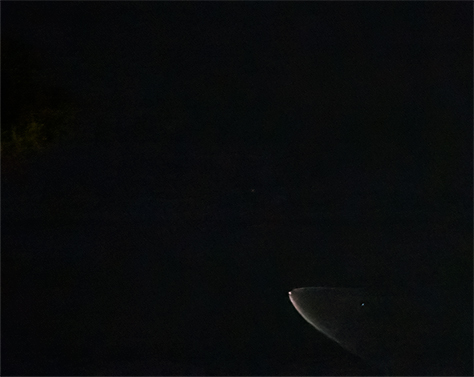 |
| perseids wide field 8/12-13/23 north lower right radiant at perseus right side |
having repeatedly tried and failed to catch any meteor images in my back yard over the past few years, i elected to go out to the Orange County Astronomers dark sky site in anza to image this year's perseids with near new moon conditions.
 |
| Burn line from recent fires near OCA site Dave Kodama's cameras ready to go |
 |
| OCA regular heungsoo choi in action |
 |
| perseid buzzing OCA's anza house 8/12/23 23:06 |
while i've seen meteor showers from dark skies, including Yosemite and Yellowstone parks, this was in many ways the best. others have had more frequent bursts, but these were typically faint white lines. this night's show was filled with bright orange streaks. by no means a meteor storm--the bright one's trickled in, but there were more than i've ever seen. over the course of 7 hours, even with passing clouds, my camera captured 21 bright meteors. they were rainbow colored in the camera, changing from red to green as they heated in the atmosphere, despite an orange visual appearance.
 |
| perseid 8/13/23 00:50 local time |
there were many faint meteor candidates, but they were difficult to confirm due to abundant satellite traffic. i only included bright streaks that were colored and directed towards the radiant in perseus.
I used a fisheye lens to capture a wide swathe of sky, nearly horizon to horizon:
 |
| milky way center, perseid top left N-north star, A-andromeda galaxy, P-constellation perseus northern horizon bottom left southern horizon top right SUV bottom right :( 8/13/23 00:50 local time |
sadly, there were clouds passing through many of the images, making a composite difficult.
 |
| Star trails 8/12-13/23 polaris, north star lower left anza house bottom left corner my annoying SUV side light bottom right corner southern horizon top right corner (click for larger size) |
typical recommendations are to just sit back and look up to view meteors.
 |
| meteor shower observing accessory |
the distribution in this capture was skewed towards the radiant in perseus on the horizon. however, many of those were foreshortened with longer streaks on the opposite horizon.
 |
| perseid distribution map 8/12-13/23 (click for larger size) |
the best time to view meteors is between midnight and dawn. i've also read 4 AM.
 |
| a steady stream with clusters at 2AM and 3AM |
5/12-13/23 10 PM to 5 AM
Anza, CA
passing clouds
nikon D850
Sigma 15mm F/2.8 EX DG fisheye
20 sec, iso 1600
missed the first hour as i set the camera delay to 20 minutes instead of 20 seconds between shots :(
the last meteor was caught at 5 AM, after astronomical dawn. i saw several bright meteors as i was setting up, so i should have started imaging much sooner despite the "after midnight" recommendations.






















